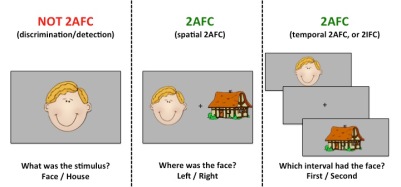Probably not.
You probably know that 2AFC stands for “two-alternative forced choice.” However, you may not know that this means 2AFC tasks involve the presentation of two stimuli on each trial!
Let’s say that you want your participants to distinguish between faces and houses. On each trial, you present an image and ask participants to decide if it’s a face or a house. This is a fantastic design, just not a 2AFC task. Rather, it’s a discrimination task though some psychophysicists would also call it a detection task. Likewise if your subjects are judging the direction of motion in a random dot kinematogram, or if they are deciding whether an item is old or new, or whenever they are judging a single stimulus per trial.

So, what are 2AFC tasks? There are two variants: spatial 2AFC and temporal 2AFC (also called two-interval forced choice, or 2IFC). In the spatial 2AFC, on each trial you’d present a face and a house in different locations (usually left and right of fixation). In 2IFC tasks, on each trial you’d present first the face and then the house (or vice versa) in the same spatial location. In both cases, participants’ task is to determine which of the two stimuli was the face.
Despite my best efforts, I haven’t been able to find out how the confusion around what a 2AFC task is emerged. According to this Wikipedia page, Fechner developed 2AFC back in the 19th century. Confusing 1-stimulus discrimination tasks with 2AFC seems to have already been the rule by the middle of the 20th century (and perhaps much earlier). It appears to be the rule now, at least outside of the vision science world.
What is so special about 2AFC tasks? They are supposed to be ‘unbiased.’ In other words, subjects are often assumed not to have much of a bias between left/right or first/second interval decisions. Such lack of bias is great for measuring performance and generally makes distributional assumptions (like assuming Gaussians in SDT) unnecessary. The problem is this assumption has been shown to be empirically false (Yeshurun, Carrasco, & Maloney, 2008). Yeshurun and colleagues even recommend against using 2IFC tasks altogether.
A note on comparing 1-stimulus discrimination and 2AFC tasks: because 2AFC tasks present two stimuli on each trial, participants have more information to work with and thus are expected to perform better. In fact, their signal-to-noise ratio (d’) should be exactly √2 higher in 2AFC tasks. Empirically, however, it has been found to be both substantially higher or substantially lower. Math is prettier than actual human performance!
In the end, perhaps it’s not a bad thing if you’ve used a simple discrimination task in your experiment. Just don’t call it 2AFC.
Thanks for the clarification! Can I ask a potentially stupid question? What if you show a single stimulus (say Face or House masked and briefly), but then you show both stimuli during the decision stage? E.g. let the ppt toggle between Face and House, shown side by side. The earlier part of the trial (defining the target) seems to fall under single stimulus, but the latter seems 2AFC-y. Or not? The question becomes something like ‘Is the thing you saw earlier on the left or right now?’ Is that closer to ‘did you see the face/house’ than ‘was the face shown on the right’?
LikeLike
This is actually an altogether different design. In psychophysics terms, it would probably be called “XAB” design: you judge whether X is A or B, and both A and B are presented on each trial. The only catch is that traditional XAB designs are sequential: X, A, and B are presented one after the other in temporal succession (by the way, the much more standard design in psychophysics is the ABX). In any case, it’s definitely not 2AFC. Perhaps you just shouldn’t attach a specific name to this design in your write-up.
LikeLike
[…] пост, разъясняющий специфику 2AFC […]
LikeLike
Was glad to see this article. Was trying to figure out the real differences between Yes/No and 2AFC tasks. Interestingly, while the Wikipedia article on 2AFC cautions against using the term 2AFC to describe Yes/No tasks, it gives the random dot kinetogram task as an example of a 2AFC task.
LikeLike
Hello, thanks for this post. It’s really helpful. Can I ask one question regarding my test design?
Would it be ok to ask a Yes-No question (e.g. was there a difference between A and B?) in a test with 2 stimuli? and can it still be called a 2AFC test? Or is it valid to do a Yes-No test with two stimuli?
I am asking this with regard to a threshold test using a 2AFC transformed staircase (2 down 1 up procedure). It’d be a lot easier for subject to respond whether there was a perceivable difference between two stimuli rather than having to choose the stronger one. As my main interest is to see just noticeable difference, which is stronger is not of a concern. However, I guess there must be a specific reason why one stimulus has to be chosen over the other in a 2AFC test (re bias and sensitivity). And I wonder what would be the implication of using a Yes-No question instead.
If this is a totally new design, do you think this can be validated?
Many thanks in advance for your help.
LikeLike